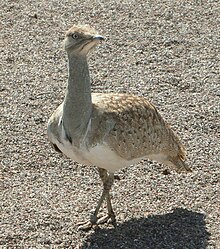Houbara bustard
| Houbara bustard | |
|---|---|
 |
|
| Scientific classification | |
| Kingdom: | Animalia |
| Phylum: | Chordata |
| Class: | Aves |
| Order: | Otidiformes |
| Family: | Otididae |
| Genus: | Chlamydotis |
| Species: | C. undulata |
| Binomial name | |
|
Chlamydotis undulata (Jacquin, 1784) |
|
 |
|
The houbara bustard or North African houbara (Chlamydotis undulata) is a large bird in the bustard family. This bustard is found in arid habitats spread across northern Africa and Southeast Asia with a population on the Canary Islands. They are dull brown with black markings on the wings with a greyish neck and a black ruff along the side of the neck. Males and females appear very similar but males are larger and heavier. This species formerly included MacQueen's bustard which is found further east and sometimes known as the Asian houbara as a subspecies.
The houbara bustard is a small to mid-sized bustard. It measures 55–65 cm (22–26 in) in length and spans 135–170 cm (53–67 in) across the wings. It is brown above and white below, with a black stripe down the sides of its neck. In flight, the long wings show large areas of black and brown on the flight feathers. It is slightly smaller and darker than MacQueen's bustard. The sexes are similar, but the female, at 66 cm (26 in) tall, is rather smaller and greyer above than the male, at 73 cm (29 in) tall. The body mass is 1.15–2.4 kg (2.5–5.3 lb) in males and 1–1.7 kg (2.2–3.7 lb) in females.
The former Asian subspecies, C. u. macqueenii, has now been split as a full species, MacQueen's bustard, Chlamydotis macqueenii. These two species are the only members of the Chlamydotis genus. The Canarian houbara is the subspecies Chlamydotis undulata fuertaventurae. The dividing line between the two Chlamydotis species is the Sinai peninsula. Based on the rates of divergence of mitochondrial DNA sequences, the two subspecies are thought to have separated from a common ancestor around 20 to 25 thousand years ago. The separation from MacQueen's bustard is older at 430 thousand years ago.
The British Ornithologists' Union's Taxonomic Records Committee's decision to accept this split has been questioned on the grounds that the differences in the male courtship displays may be functionally trivial, and would not prevent interbreeding, whereas a difference in a pre-copulation display would indicate that the two are separate species. The committee responded to this scepticism, by explaining that there are differences in both courtship and pre-copulation displays.
...
Wikipedia

